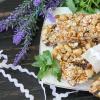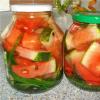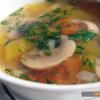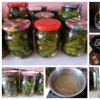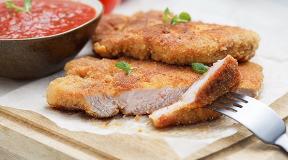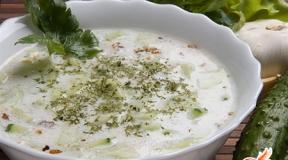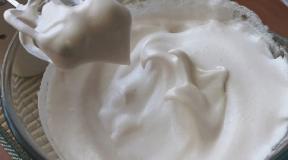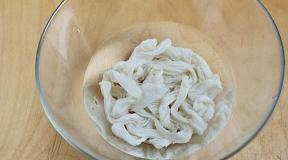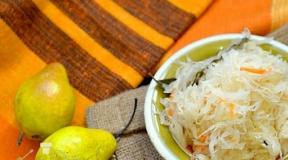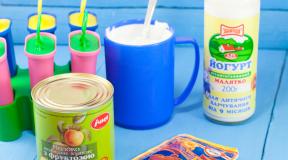How to increase hemoglobin in a child. We increase the hemoglobin of the child with the help of food and medicines. Medicines for the treatment of childhood anemia
The baby was diagnosed with anemia, and the parents are starting to look for: how to increase the hemoglobin in the child. Correction of this indicator is necessary, because a decrease in hemoglobin level leads to a deterioration in the supply of tissues and organs with oxygen. The resulting condition is dangerous for the child's body and, without treatment, causes a developmental delay.
In contact with
classmates
If the decrease in hemoglobin is not caused by diseases that disrupt the production of red blood cells, then you can raise it at home, observing medical prescriptions.
 In children with a moderate decrease in hemoglobin, you can try to raise the hemoglobin protein in the blood with the help of iron-containing products. The child's diet must include:
In children with a moderate decrease in hemoglobin, you can try to raise the hemoglobin protein in the blood with the help of iron-containing products. The child's diet must include:
- turkey and rabbit meat;
- offal;
- beef;
- chicken yolks;
- seafood;
- legumes;
- buckwheat porridge;
- vegetables and fruits;
- nuts.
The dried apricot compote will also help to raise the hemoglobin in the child's blood.
The consumption of muffins, chocolate, condensed milk and sugary soda should be limited, and it is better to completely exclude from the diet these foods that reduce the level of hemoglobin protein.
Dairy products slow down the absorption of iron, but it is impossible to completely exclude milk from the child's diet - calcium is necessary for growth. During treatment, it is recommended not to mix dairy products with iron-containing foods.
With anemia, even in mild form, since it is impossible to raise the hemoglobin level with food alone, the child is prescribed medications with iron. There are quite a large number of them, dozens of names. Preparations in syrups and solutions can be used for children, practically without age restrictions:
- Ferrum-lek;
- Ferlatum;
- Totem (from 3 months).
For children, an accurate calculation of the dose is required, which is carried out based on the weight of the child.
Iron supplements for children are well absorbed in the intestines, taste good and help to quickly raise hemoglobin. Iron injections to raise hemoglobin are rarely prescribed. The indication for injections is a significant decrease in the level, which poses a threat to life.
What if a baby has a low level of Hb in the blood?
To begin to raise hemoglobin in a breastfed baby, you should correct the menu of a nursing mother. A woman needs to eat:
- beef;
- liver and other offal;
- vegetables;
- fruits and berries;
- legumes;
- seafood.
But, trying to raise hemoglobin in the baby, you cannot eat many recommended foods - this will cause digestive upset in the child. New food should be added to the diet in small portions and the baby's stool should be monitored. If the baby is feeling well, then the next day you can add another healthy dish.

The diet of an older child must necessarily be healthy and balanced.
The adapted iron-containing mixtures will help to raise the infant who is on artificial feeding, hemoglobin. Health food is selected by a pediatrician taking into account the characteristics of the disease.
Anemias in pregnant women are often detected due to the fact that the growing child actively consumes iron, depleting the reserves of the mother's body. Women are interested in how hemoglobin can be raised so as not to harm the fetus and improve their well-being. Doctors recommend:
- include iron-fortified foods on the menu;
- take iron-containing agents (with a strong decrease in hemoglobin index).
If anemia is detected, it is necessary to be treated immediately. A pathological decrease in hemoglobin causes fetal hypoxia and becomes the cause of intrauterine growth retardation.
Useful video
Practical tips on how you can increase your child's hemoglobin:
Conclusion
- Low hemoglobin in a child is a serious problem, since with long-term preservation it affects physical and mental development.
- An iron-saturated diet without the use of iron-containing preparations is not able to increase hemoglobin in a child.
- Medicines are used the same as for adults, but in a reduced dose. Children under 6 years old can only be given syrups and solutions. Chewable tablets are also becoming an acceptable option. All three forms of release are different pleasant smell and sweet taste, which is why they are well accepted by children.
In contact with
Anemia in babies under three years old is diagnosed in 50% of cases, in adolescents in 30% of cases. This is one of the most common pathologies in children. In 80%, it is caused by iron deficiency. Due to the prevalence of the disease, many neglect full-fledged treatment, replacing the intake of medication with a diet. According to the opinion of the authoritative researcher of the problems of anemia L.I. Idelson, it is impossible to compensate for the lack of hemoglobin only at the expense of food, the diet is only an auxiliary tool. At the same time, it has been proven that a long-term hemoglobin deficiency can lead to a delay in the mental and physical development of a child. Therefore, even mild treatment degree of anemia without taking iron supplements will be ineffective, and moreover, dangerous. This article will discuss how to raise hemoglobin in a child and which drugs to choose for this.
How to increase the level of hemoglobin in a child depends primarily on age. It is important to choose the right drug treatment and the dosage of medications taken. Iron supplements are metabolized in different ways and can cause mass side effects... For this reason, the treatment should be prescribed by a doctor, taking into account all the characteristics of the body and the course of the disease.
Causes and symptoms of anemia in children
Signs of low hemoglobin in a child are often absent or can be attributed to age and other health problems. Therefore, anemia is detected only after general analysis blood. After detecting anemia, the pediatrician decides how to raise hemoglobin in the child.
Symptoms of anemia in children:
- Decreased appetite;
- General weakness and fatigue;
- Changes in the skin - dryness, pallor;
- Lag in weight gain according to age;
- Sleep disturbance;
- Mental and physical developmental delay;
- Pallor of the skin and mucous membranes;
- Pronounced nasolabial triangle;
- Blueness of the auricles;
- Decreased immunity, as a result, frequent viral and infectious diseases;
- Excessive sweating.
In adolescence, the listed symptoms may be added:
- Muscle weakness;
- Irritability and tearfulness;
- Impairment of memory and learning ability;
- Depressive states.
The severity of symptoms depends on the age of the child. In children younger age they are less noticeable than in older ones. There is also a relationship between the severity of symptoms and the degree of development of anemia. The lower the hemoglobin count, the greater the set and intensity of symptoms can be observed in the child.
The reasons why the hemoglobin level may decrease can be physiological and pathological... Depending on this, a method is selected how to raise hemoglobin in a child.
Anemia in infants develops as a result of:
- Lack of vitamin B12 and folic acid;
- Insufficient complementary foods or late introduction;
- Unbalanced diet of a nursing mother;
- Development pathologies.
In the youngest children, hemoglobin values are especially unstable, so it is important for parents to know how to raise breast hemoglobin. Which means are effective and which are useless or even dangerous.
A lack of hemoglobin in adolescent children is considered almost inevitable, so mothers need to know how to raise hemoglobin in a child. It arises from accelerated growth muscle mass and puberty, during this period the body's need for iron increases sharply, and to get the necessary daily dose only from food is extremely difficult.
Exists common reasons for children of all ages who are able to provoke anemia:
- Helminthic invasions;
- Tendency to allergic reactions;
- Rare walks in the fresh air;
- Taking certain medications.
Treatment if diagnosed is necessary. But how to raise hemoglobin in a child's blood? Iron supplementation is recommended without fail. In addition, therapy can be supported by adherence to the diet and the introduction vitamin complexes... The latter is necessary to obtain a sufficient amount of vitamin B12, which is involved in the synthesis of hemoglobin and vitamin C, which promotes the absorption of iron. A set of specific measures is selected taking into account age characteristics, the way how to raise hemoglobin in a small child and which drug to choose is determined by the pediatrician.
How to raise hemoglobin in an infant
One of the most difficult questions is how to raise hemoglobin in a newborn baby. He does not eat adult food yet, but medications can cause side effects.
If the child is on gv ( breastfeeding) how to raise hemoglobin? There are not many options: through mother's milk and by taking iron-containing drugs in the form of drops. A nursing mother should balance her diet and introduce foods rich in iron, vitamins B12 and C. These are beef, offal, vegetables, herbs.
Important! When planning the diet of a nursing mother, you need to exclude foods that can cause allergies in the baby, since it is important to raise the hemoglobin of the baby with minimal harm to his body.
How to raise hemoglobin in a baby with medication? Iron preparations are introduced gradually. Reception begins with the minimum dose of the medication. Within a few days, it is brought to the therapeutic level. This is necessary for the timely assessment of the reaction of the child's body to the drug and the addiction of the mucous membranes of the stomach and intestines.
If a nursing mother suffers from a lack of iron, then the baby will soon have the same problem. Therefore, it is important to know how to raise hemoglobin for a nursing mother and baby at the same time. In this case, taking an iron-containing drug for the mother is mandatory, the prescription of drug treatment for the child is made by a pediatrician on the basis of a blood test.

How to raise hemoglobin in breastfed babies
For babies who are bottle-fed, it is recommended to eat special mixtures with increased content gland. This measure will slightly adjust the level of hemoglobin, but taking iron supplements with a serious deviation from the norm is necessary. The most convenient form of release of such drugs for babies early age- drops.
Children on artificial feeding with reduced hemoglobin need to reduce or completely exclude cow's milk from the diet - calcium binds iron and does not allow it to be absorbed.

How to increase hemoglobin in a child under 1 year old
At the age of 1 year, the treatment of anemia is complicated by the inability to use many foods high in iron and vitamin complexes, then how to raise hemoglobin in babies? To answer this question, it is important to identify the cause of the anemia.
In children under 1 year of age, the development of anemia may be associated with physiological reasons... In a baby born on time, an iron deficiency occurs by the 6th month of life, during which time he uses the reserves of a trace element received in the womb. Therefore, every mother should know how to recognize a low rate in a baby and how to raise hemoglobin in a child at the age of 6 months. In premature babies, anemia appears as early as 2 months of age. Pediatricians are ready for such a development of events and are choosing a way to raise hemoglobin to a child at 2 months in advance and be sure to inform the mother about it.
The rate of iron intake in babies up to 3 months is at least 4 mg, by the year the need increases to 10 mg. For comparison, buckwheat contains 8 mg of non-heme iron per 100 g, but no more than 6% of iron is absorbed by the body. Heme iron, contained in animal products, is absorbed better - up to 35%. However, this is not enough to treat anemia, so iron supplementation is recommended as the primary treatment and dietary supplementation.
How to raise hemoglobin for a child under one year old in different age periods see the table.
| Child's age | Hemoglobin rate (M / F) | How to raise |
| How to raise hemoglobin in a child through milk | According to age | Correction of nutrition of a nursing mother. Taking iron supplements in the form of drops |
| How to raise hemoglobin in a bottle-fed baby | According to age | Introduction of mixtures with high content gland. Eliminate or reduce consumption of cow's milk. Taking iron-containing drugs in the form of drops |
| How to increase hemoglobin in a month old baby | In the first 3 days - 145-225 g / l. At the age of 1 week - 135-215 g / l. 14 days - 125-205 g / l. By 1 month - 100-180 g / l | |
| How to raise hemoglobin 2 month old baby | 90-140 g / l | Depending on the type of feeding: a mixture with a high iron content or a change in the diet of a nursing mother. Iron preparations in the form of drops |
| How to raise hemoglobin in a three month old baby | 95-135 g / l | Depending on the type of feeding: a mixture with a high iron content or a change in the diet of a nursing mother. Iron preparations in the form of drops |
| How to raise hemoglobin in a baby at 4 months | 95-135 g / l | With the permission of the pediatrician, you can introduce dried fruit compote, rosehip decoction. Iron preparations. Compliance with the diet of a nursing mother or a mixture with iron content |
| How to raise hemoglobin in a 5 month old baby | 95-135 g / l | If the child is ready for the introduction of complementary foods: cereals, vegetable and fruit purees. The main source of iron is mother's milk, formula and iron supplements |
| How to increase hemoglobin in a 6 month old baby | 95-135 g / l | Complementary foods: fruit and vegetable purees, compote, rosehip broth. Iron preparations |
| How to raise hemoglobin in the blood of a child of 7 months | 100-140 g / l | Groats: buckwheat, corn. Fresh vegetables, fruits in the form of mashed potatoes. Juices, compotes. Iron preparations |
| How to raise hemoglobin in a baby at the age of 8 months | 100-140 g / l | Introduce egg yolk, meat products in the form of puree into the diet. Buckwheat and corn porridge. Vegetables and fruits. Iron preparations |
| How to raise hemoglobin in a 9 month old baby | 100-140 g / l | You can add rabbit meat, beef, chicken to the diet. Iron supplements - the main treatment for anemia |
| How to raise hemoglobin in a 10 month old baby | 100-140 g / l | Introduction to the diet of prunes - they are high in iron. Iron preparations |
| How to raise hemoglobin in a child at 11 months | 100-140 g / l | You can enter fish, vegetables and fruits in small pieces. If breastfeeding continues - diet for mom. Iron preparations |
How to effectively raise hemoglobin in a child under 1 year old? In addition to treatment and diet, frequent walks in the fresh air, gymnastics, adherence to sleep and wakefulness are recommended, it is also advisable to avoid stressful situations.
How to raise hemoglobin in a one-year-old child
If a one-year-old child has low hemoglobin, then how to raise it? The daily requirement for iron in children aged 1 year is 10 mg. The norm of hemoglobin in the blood is 100-140 g / l, with a decrease in the indicator below 100, iron preparations are prescribed. But only if anemia is associated precisely with a deficiency of a trace element, and not with its poor absorption or other diseases. Excess iron is no less harmful! Therefore, the appointment of drugs for the treatment of anemia can only be prescribed by a specialist.
Ways to raise hemoglobin in a child at 1 year old with iron deficiency anemia are the same as before a year, but taking into account a wider diet, weaning, refusal of the mixture and other factors. A baby can get more iron from foods, but if the deviation from the norm is downward, an iron-containing drug is also prescribed. About how to raise hemoglobin in a child at 1 year old, Dr. Komarovsky says: proper nutrition can only maintain a normal level of hemoglobin, but it is extremely insufficient to treat anemia. To the question of how to raise hemoglobin in a child, Dr. Komarovsky, like most pediatricians, answers unequivocally - to take iron supplements.
The pediatrician should determine how to raise the hemoglobin of a child with drugs, the first thing he will need to find out is what caused the anemia. Only the most common form of iron deficiency is treated with iron preparations; in other forms of the disease, such therapy will not be effective enough.
In addition to treatment, there are other ways to raise hemoglobin in a 1 year old baby. From this age, in agreement with the pediatrician, it is possible to take vitamins. For good absorption of iron and synthesis of hemoglobin, it is recommended to walk more in the fresh air. Moderate physical activity and healthy sleep are also required.
How to increase hemoglobin in a child aged 2 years
At the age of 2 years, the baby is already switching to an adult table, so if the hemoglobin indicator is normal, then it can be maintained with food. The diet of a healthy child must include:
- Meat and offal (beef, pork, poultry, liver);
- Eggs (egg yolk);
- A fish;
- Cereals (buckwheat, wheat);
- Vegetables, fruits and herbs, dried fruits, berries.

If, as a result of the analysis, anemia was detected, then how to raise hemoglobin in a 2-year-old child is determined by the pediatrician. In case of an iron deficiency, an iron preparation will be prescribed.
Parents are often interested in how to raise hemoglobin in a 2-year-old child, Dr. Komarovsky believes that only by taking medication. Nutrition can meet the daily micronutrient requirement, but does not lead to an accumulation of iron stores, so anemia will persist.
How to raise hemoglobin in a child 3 years old and older
At the age of 3 years, the child eats "adult" food. Most foods with a high iron content are already allowed for him. Therefore, at balanced nutrition the problem of iron deficiency anemia will not arise.
If a blood test showed a low level of hemoglobin, then the first thing to do is to identify the cause of the pathology. Only then should it be decided how to raise hemoglobin in a child 3 years of age and older.
Children's diet may include hematogen, but only for maintenance normal level hemoglobin, he is not able to cure anemia, as well as nutritional correction.
How to increase hemoglobin in a child 4 years old and older? The daily requirement of a child under 6 years of age for iron is 10 mg, for 7-10 years - 12 mg. It can be replenished with such products as: beef, offal (liver, lungs, tongue), pork, fish, fruits, vegetables, berries and herbs. The use of vitamin complexes containing vitamins C and B12 is recommended. If the hemoglobin indicator deviates from the norm by more than 5 mg, it is necessary to take iron-containing drugs in drops or tablets. These are all possibilities of how to raise hemoglobin in a child aged 4 years and older and keep it normal.
Which iron supplements are suitable for children
The process of assimilation of iron in the child's body from drugs is determined by the group to which this trace element belongs in a particular drug. So ferrous iron absorbed better than trivalent. It is ferrous iron that is contained in the Hemobin preparation. It is produced on the basis of purified animal hemoglobin. Heme iron from this drug is absorbed by 90%. At the same time, Gemobin, unlike most drugs for anemia, does not cause side effects. Its effectiveness has been confirmed as a result of clinical trials, during which it was revealed that the drug is able to restore hemoglobin levels in a short time in both adults and children. None of the people who took part in the study experienced allergic reactions and side effects.
The release form of the drug is tablets. Each contains 4 mg of heme iron and 5 mg of ascorbic acid.
- Hemobin is introduced gradually, starting with half the dose, with a normal reaction of the child's body, the dosage is increased to therapeutic.
- Iron is less absorbed when interacting with food, therefore it is recommended to take the tablets 1 hour before meals.
- The general course of taking the drug depends on the degree of anemia, the minimum course of treatment is 20-30 days.
- Regular blood tests are recommended to monitor changes.
- Hemobin is available only in tablet form, so for babies, they need to be crushed and dissolved in juice, water or food.
How to quickly increase hemoglobin in a child using Hemobin, see the table.
| Child's age | Iron consumption rate per day | Hemobin dosage |
| How to raise hemoglobin in a newborn | From 4 mg | The first three days ½ tablet per day. Then 1 tablet per day. |
| How to raise hemoglobin in a month old baby | From 4 mg | |
| Low hemoglobin in a child 2 months how to raise | From 4 mg | |
| How to raise hemoglobin in a 3 month old baby | From 4 mg | |
| How to increase hemoglobin in a child aged 4-5 months | 10 mg | |
| How to raise hemoglobin in a child from 6 months to a year | 10 mg | |
| How to raise hemoglobin in a child at 1 year old | 10 mg | The first three days, 1 tablet per day. Then 1 tablet 2 times a day. |
| How to raise hemoglobin in a 1.5 year old child | 10 mg | |
| How to raise hemoglobin in a baby at 2-4 years old | 10 mg | The first 3 days, 1 tablet twice a day. Then 2 tablets twice a day |
| How to raise hemoglobin in a 5-year-old child | 10 mg | |
| How to raise hemoglobin in a 6-year-old child | 10 mg | |
| How to raise hemoglobin in a 7-year-old child | 12 mg | |
| How to raise hemoglobin in a child aged 8 | 12 mg | 2 tablets three times a day |
| How to raise hemoglobin in a child aged 10 and older | 15-18 mg |
Decreased hemoglobin level per unit of blood volume. Recently, this disease has become even more common than in adults. This is due to the anatomical immaturity of the hematopoietic organs resulting from negative influence a number of environmental factors. Anemia is usually divided into several types, among which the most common is the so-called deficiency anemia. Somewhat less common hemolytic anemia caused by the destruction of red blood cells, anemia after severe blood loss, hereditary anemia, etc.
Decreased is accompanied by specific persistent symptoms that allow it in time. The child becomes lethargic, his appetite is disturbed, or, on the contrary, he is drawn to eat everything, including chalk, wax, paper. The skin of such a child becomes pale and cold, and the hair becomes brittle. But even if none of these symptoms occur, anemia will be detected on the first blood test.
The so-called deficiency anemia can occur due to a lack of iron (iron deficiency anemia), or a lack of any vitamins. Deficiency anemia can also be secondary. In this case, the cause of the disease is not an unhealthy diet, but a violation of the function of absorption of nutrients in the intestine.
If the cause of low hemoglobin is iron or vitamin deficiency, you should turn to. When the diagnosis is confirmed, it is necessary to increase the child's protein intake. They can enter the body, in particular, in the form of meat or eggs. However, do not forget that even with anemia, the intake of animal protein should not be exceeded. You also need to give your child milk and applesauce, since apples contain a lot of iron.
With vitamin deficiency, usually prescribed folic acid, since anemia in children is often precisely because of its lack. In addition, the child can take a complex of other vitamins. In order to increase the level of hemoglobin, which has decreased due to vitamin deficiency, the child should be given such useful plants, fruits and berries as rhubarb, rose hips, bananas. Kissels and compotes from rhubarb compensate for the deficiency of vitamin C and some minerals. Also rhubarb contains malic acid. For children from one to two years old, it is best to give jelly and rhubarb compotes along with rose hips. In addition, bananas should be added to the diet.
It is important to know that sometimes too monotonous food becomes the cause of low hemoglobin in children. Therefore, it is necessary to include in the child's diet all foods that are said to be consumed in the first year of life.
There are other forms of anemia, such as Fanconi's anemia, which is congenital. With this form of anemia, along with a decrease in the level of hemoglobin, the child may lag behind in growth and development. Such anemia appears in the first years of life. However, as with ordinary anemia, you should still diversify your diet and use vitamin complexes.
Iron is an essential trace element for the child's body. Without it, the process of hematopoiesis and the synthesis of hemoglobin, a complex blood protein that supplies oxygen to cells and tissues, is impossible.
The child's need for iron directly depends on his age. Insufficient intake of this trace element with food can lead to a deterioration in the well-being of the baby, metabolic disorders and iron deficiency anemia.
To determine the child's current hemoglobin level, it is enough to take a general blood test.
What is the norm of hemoglobin in children?
First of all, you need to understand that comparing the performance indicators of a newborn and a child who is one year old is a useless exercise. The norm of hemoglobin, which ranges from 90 to 225 g / l, directly depends on the age of a particular crumbs.
For example, in a newborn baby, the hemoglobin index is in the range from 145 to 225 g / l. Further, it gradually begins to decline.
How does the amount of iron in a child's body change with age?
After the first week of life, hemoglobin falls, decreasing to its lowest value by 2 months of life.

Medicine explains this by the fact that the "reserves" accumulated during the intrauterine iron are almost completely wasted, and the only source of the most important chemical element becomes maternal breast milk or its artificial substitutes (milk formulas).
For full-fledged active growth, the child's body needs an additional portion of this trace element. Therefore, a nursing mother should follow a diet rich in plant and animal products and high iron content.
Features of the introduction of complementary foods for babies
The first complementary foods for babies who are breastfed can be introduced at the age of six to seven months. It is possible to expand the diet of artificial babies who ate mixtures a little earlier, from five to six months.
Since the introduction of complementary foods, the infant has to replenish depleted iron stores from "adult" foods.
To independently synthesize hemoglobin in the required amount children's organism will learn by the year when all the necessary biochemical processes will be activated.

Particular care and vigilance must be shown to mothers of babies who are bottle-fed, since it is in this case that iron deficiency anemia is most common.
The risk group also includes mothers who are breastfeeding, whose hemoglobin level during pregnancy was determined to be below normal.
What is iron deficiency anemia?
Iron deficiency anemia is a laboratory-clinical syndrome that develops in a child's body in the event of a lack of iron, as well as disruptions in the processes of its assimilation, intake or consumption.
As statistics show, the prevalence of the disease among children under three years old is approximately forty percent, and thirty percent - when it comes to adolescents.
Symptoms of iron deficiency anemia in children
The main sign of the development of iron deficiency anemia is considered to be pallor of the mucous membranes and skin. However, the range of symptoms in this disease can be much wider.
So, for example, with a lack of iron, in addition to pallor, a child may experience:
- excessive dryness of the skin, their peeling and cracking;
- violation of taste and smell;
- fragility and curvature of the nail plates;
- hair loss and poor hair growth;
- decreased appetite;
- the development of caries;
- diseases of the digestive organs;
- excessive fatigue. The child often experiences headaches, he is emotionally unstable, complains of tinnitus. In some cases, delayed psychomotor development is possible;
- delayed physical development. May manifest as urinary incontinence or sphincter weakness;
- decline blood pressure and shortness of breath. Listening to the child's heart often ends with the identification of functional systolic murmurs;
- frequent respiratory diseases, which are quite acute. This is due to damage to the barrier tissues.
There are a lot of characteristic symptoms, however, iron deficiency anemia can be diagnosed only after a general blood test, as a result of which the level of erythrocytes, hemoglobin, as well as a change in the color index will be established.

Causes of low hemoglobin levels
In infants
The following factors can provoke a decrease in hemoglobin in infants:
- Insufficient amount of vitamin B12, as well as folic acid.
- Late introduction of complementary foods.
- Incorrectly constructed menu for a nursing mother. Often the reason for the development of iron deficiency in an infant is the mother's vegetarian diet. Greens, of course, contain a large amount of iron, but it is absorbed much worse in comparison with meat products;
- Low physical activity of the child.
- Pathologies that occurred during childbirth or pregnancy.
In adolescents
If we talk about adolescent hemoglobin crisis, it is worth noting that it can occur at nine and fifteen years. Most often, it coincides with a psychological crisis and is considered inevitable. The rapidly flowing process of physical maturation provokes the development of iron deficiency.
Even a teenager who seems completely healthy can become whiny, aggressive. Depression and apathy overtake him. These symptoms coincide with signs of anemia. Therefore, you cannot blame the child for this, it is worth checking his blood. If the anemia is confirmed, the teenager will be prescribed treatment.
For babies of all ages
In addition, common causes of low hemoglobin in children of any age can also include:
- infection with worms,
- the occurrence of allergic reactions,
- frequent use of medications,
- lack of fresh air in winter.
Why is iron deficiency dangerous for a child?
The main function of hemoglobin can be called the transport of oxygen directly from the lungs to each cell of the body, as well as the removal of carbon dioxide from them.
 A decrease in hemoglobin entails a deterioration in the work of the oxygen supply system of the whole body, as a result of which tissues and organs fade faster, age, and cease to cope with their functions.
A decrease in hemoglobin entails a deterioration in the work of the oxygen supply system of the whole body, as a result of which tissues and organs fade faster, age, and cease to cope with their functions.
The lack of a substance provokes a weakening of the protective forces of the immune system. Reduced protective barriers do not prevent bacteria and infections from entering the body. The immune system works with serious interruptions. As a result of even a banal cold, the baby may have complications.
How is iron deficiency anemia treated?
How to increase hemoglobin? To quickly bring the child's hemoglobin count to normal, doctors usually prescribe special medications that contain iron. However, this is not the only way to increase the level of iron in the body.
If the hemoglobin level is only slightly behind the norm, doctors recommend replenishing the iron deficiency by including iron-rich foods in the diet. And although they are much slower to restore the balance of micronutrients, they have fewer contraindications and side effects than drugs.
And remember, in no case should you self-medicate iron deficiency in a child, and even more so give your baby iron supplements without a doctor's prescription! Such a diagnosis should be made solely on the basis of test results and only by a medical specialist!
Optimal conditions for hemoglobin production
Balanced diet
So that the hemoglobin indicator does not leave the normal range, the child must eat right. His diet should include foods that contain iron, for example: beef, turkey, buckwheat, pomegranate, liver, legumes, veal, eggs, dried apricots.
Food of animal origin is still preferable, since the iron contained in it is better absorbed. In addition, in order for the absorption of the microelement to be fast and effective, the baby should eat more fresh fruits and vegetables.
Particular preference is given to those fruits that contain vitamin C.
Healthy lifestyle
An equally important condition for maintaining a normal level of macro- and microelements in the child's body also becomes healthy image life.
Hemoglobin will be kept normal if the child spends more time outdoors, playing active, outdoor games, playing sports, or at least doing morning exercises.
However, it should be understood that high activity and poor nutrition will negatively affect the level of hemoglobin.
Diet to increase hemoglobin in children
Meat, offal, seafood
A nursing mother and a child whose hemoglobin level is below the level should adhere to a specific diet. The main product, which contains a sufficient amount of easily digestible iron, is beef, preferably boiled or steamed.
The diet should also include various by-products: kidneys, lungs, liver.
If we talk about fish, then the iron content in it is low. Instead, it is better to prefer other seafood: caviar, shellfish and shrimp.

Buckwheat and legumes
We must also not forget about plant foods. There should always be soybeans, beans, peas or lentils, bread products made from wheat or rye flour as well as buckwheat porridge. Remember, a diet aimed at raising hemoglobin implies regular use of a side dish.
Fruits, vegetables and berries
Vegetables and fruits will also help to cope with iron deficiency. The child must be taught to eat beets, apples, bananas, spinach, carrots. The pomegranate will be the most beneficial. If we talk about berries, preference should be given to rose hips, strawberries, currants or raspberries.
Limiting dairy and tea
During the diet, the child needs to reduce the intake of foods rich in calcium (the exception is mother's breast milk). You should also temporarily remove yoghurts, sour cream and cottage cheese from the menu.
To raise hemoglobin levels faster, black and green tea, cola and other caffeinated drinks should be replaced with herbal or drinking water.
Folk remedies for increasing iron levels
The following are also capable of helping to increase hemoglobin in a baby folk remedies:
Vegetable juice made from carrots, radishes and beets
In separate containers, it is necessary to prepare juices from beets, radishes and carrots. Then mix them in a 1: 1: 1 ratio of juices. The resulting composition should be taken before meals in the amount of one spoon before meals. The course of treatment is three months.

Infusion of medicinal herbs
Grind three tablespoons of St. John's wort, two nettles, three tablespoons of chamomile and blackberries, then brew the composition with three glasses of boiling water and leave to infuse in a thermos. The resulting infusion must be given to the child in a heated form three times a day, 250 milligrams each.
Rosehip tea
Grind four to five tablespoons of rose hips into one liter of water. The broth is boiled for ten minutes, after which it is infused for about twelve hours. The resulting composition should be used by the baby instead of tea at any time of the day, regardless of meals.
Medicines for the treatment of childhood anemia
We repeat once again, iron-containing drugs can be prescribed to a child only by the attending pediatrician after the corresponding blood tests are carried out!
Remember, even the most expensive iron supplements have their own side effects... Only a doctor is able to choose the right drug and treatment regimen. In the future, therapy will be accompanied by repeated blood tests.
Specific medicine is selected for each small patient individually. For children from zero to three years old, iron-containing drugs are usually prescribed in the form of syrups, drops or suspensions. Older children may be offered medication in tablets.
A correctly selected iron-containing drug is able to increase the level of hemoglobin in a child to normal in a short time.
The question of how to raise hemoglobin in a 3-year-old child is asked by many parents. Most often, it is at this age that children begin to attend preschool educational institutions. One of the main indicators that are taken into account by medical workers when accepting a child in Kindergarten, is the hemoglobin level. Child normal rate hemoglobin has a high working capacity, good health and mood.
Symptoms of anemia in children
Children's health largely depends on the content of an indicator of iron-containing protein in the blood, which provides adequate nutrition and the functioning of the vital organs of the baby.
The norm of hemoglobin in a child at three years old is from 115 to 145 g / l. As a result of a lack of iron-containing protein in the blood, a child may develop a pathology called anemia.
Symptoms of hemoglobin deficiency in children can be determined even by external manifestations.
The child has:
- Constant fatigue and general weakness.
- Apathy and lethargy.

- Lack of appetite.
- Stomatitis.
- Violation of the digestive process.
- Blue lips.
- Dyspnea.
- Brittle nails and hair.
- Pallor and peeling of the skin.
- Irritability.
- Dizziness.
- Weakening of the immune system and frequent colds.
To determine the level of iron in the blood, it is necessary to undergo a laboratory test. If a child is suspected of anemia, the attending physician prescribes a clinical blood test (general). To control the level of hemoglobin, you need to take tests at regular intervals.
Raising hemoglobin with foods
If the baby is diagnosed with iron deficiency anemia, the doctor prescribes drug treatment. Exists modern drugs that can increase the level of hemoglobin in the blood in children. Treating anemia in children is not only possible with medications. In addition to medications, your doctor will help you adjust your baby's diet.
Every parent needs to know how to increase hemoglobin in a child with the help of a balanced diet. Certain foods tend to raise hemoglobin levels. There are many of them, and you can create a special diet suitable for the child, taking into account his taste preferences.

In case of anemia, the following meat and offal should be consumed:
- beef;
- veal;
- chicken;
- turkey;
- beef and chicken liver;
- heart;
- boiled beef tongue;
- kidneys.
Summer is the perfect time to increase hemoglobin with fresh vegetables, berries and fruits.
The table below lists foods that can help increase iron levels in children:
| Product group | Varieties | Method of use |
| Porridge and cereals | Buckwheat, oatmeal, wheat, rye, pea, lentil, oatmeal, rye | It is advisable to cook porridge for the child in the morning. Porridge is the richest source of iron. |
| Vegetables | Carrots, broccoli, beans, legumes, spinach, beets, potatoes, tomatoes, onions | As a side dish or soups |
| Fruits | Apricot, apple, persimmon, quince | Fresh or as juice |
| Berries | Kiwi, blueberries, black and red currants, pomegranate, cranberries | Natural or juiced, frozen with sugar |
| Seafood | Red, black caviar | Pure, sandwiches, add to salads |
| Greens | Turnip greens, parsley, green onions, dandelion leaves | Fresh or add to salads |
| Other | Dried fruits, dried mushrooms, Walnut, egg yolk, hematogen and dark chocolate | Consume natural |
It is recommended to refuse dairy products. This is due to the property of calcium to impair the absorption of iron. In the impossibility of giving up yoghurts or milk, iron-containing and calcium-containing foods must be eaten separately.
Folk remedies
In the fight against childhood anemia, simple folk recipes help:

- Beetroot, carrot and radish juice. You need to squeeze the juice from each vegetable separately. Then mix the juices in equal proportions. Consume 1 teaspoon before meals. Continue the treatment course for 2 months.
- An infusion of St. John's wort, nettle, chamomile and blackberry leaves. Mix the crushed raw materials in the proportion: 3 tbsp. spoons / 2 tbsp. spoons / 3 tbsp. spoons / 3 tbsp. spoons. Put the mixture in a thermos and pour 500 ml of boiling water. Insist for at least 2 hours. Drink half a glass warm 3 times a day.
- Rosehip tea. Chop the rose hips. 4 tbsp. spoon, pour 1 liter of water, boil for 10 minutes. Insist for at least 12 hours. Consume instead of drinking during the day.
It is important to remember that any folk remedies can be used after consultation with the treating doctor, especially if the sick are small children.
An important factor in the recovery and increase in the level of hemoglobin in children is the adjustment of the lifestyle. Children should spend a lot of time outside, preferably walking with them in parks or forests. It is necessary to rest with children in places far from cities and highways.
You can play sports with your child or do morning exercises, but exercise stress should be moderate. Better to play outdoor and active games.
Struggling with the deficiency of hemoglobin in children, one should not forget that its excess is an equally serious pathology. When the first symptoms of anemia appear in a child, it is necessary to apply for medical care, as well as adjust the diet and lifestyle.





